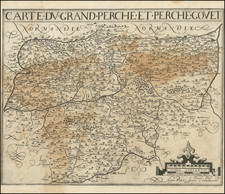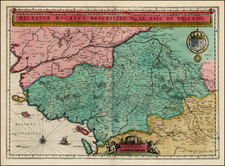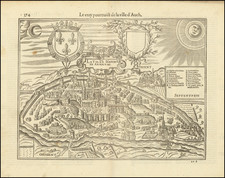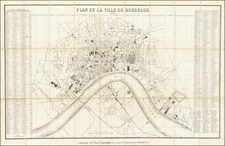Antoine Crues View of Battle of Saint-Martin
Rare copper engraved view of the naval Battle of Saint-Martin de Ré, engraved in Lyon in 1625.
Oriented with south at the top and the French coastline at the left, the view shows the battle fought on September 15, 1625 between the Huguenot fleet of La Rochelle, commanded by Admiral Jean Guiton and Admiral Benjamin de Rohan, Duke of Soubise, against the royal French fleet, commanded by Louis XIII, Charles de Lorraine, 4th Duke of Guise, Henri II de Montmorency, and Admiral Willem de Zoete, Heer Haultain, which ended with a French royalist victory and the re-taking of the Île de Ré by Catholic forces.
This view shows the sinking of several of the ships of the Huguenot La Rochelle fleet (marked S.B., perhaps for Soubise) . The sails of the French Catholic ships and some of the Dutch vessels are shown flying flags with the fleur-de-lys while the Duke of Soubise can be seen at the top of the image, jumping from his ship into a row boat, in order to flee back to the mainland at La Rochelle.
The present example lacks the text sheet which would have accompanied the image at the bottom. We locate two other example, one with full text (Royal Trust Collection) and a damaged and restored example with text header only (BnF).
The example from the British Royal Trust Collection can be seen here.: https://militarymaps.rct.uk/other-17th-century-conflicts/battle-of-saint-martin-de-re-ile-de-re-and-la-0
The example at the BnF can be seen here: https://gallica.bnf.fr/ark:/12148/btv1b8401996c.item
Rarity
The view is extremely rare.
We locate only 2 examples:
- Bibliotheque National de France (Michel Hennin collection, donated to the BnF in 1863)
- British Royal Trust Collection (From the collection of Cassiano dal Pozzo (1588-22 October 1657); inherited by his brother, Carlo Antonio dal Pozzo (1606-1689); sold by Carlo Antonio’s grandson to Clement XI, 1703; acquired by Cardinal Alessandro Albani by 1714, from whom purchased by King George III in 1762).














![[Mossaic]. Pourtraict de la ville de Moissac](https://storage.googleapis.com/raremaps/img/small/73919.jpg)